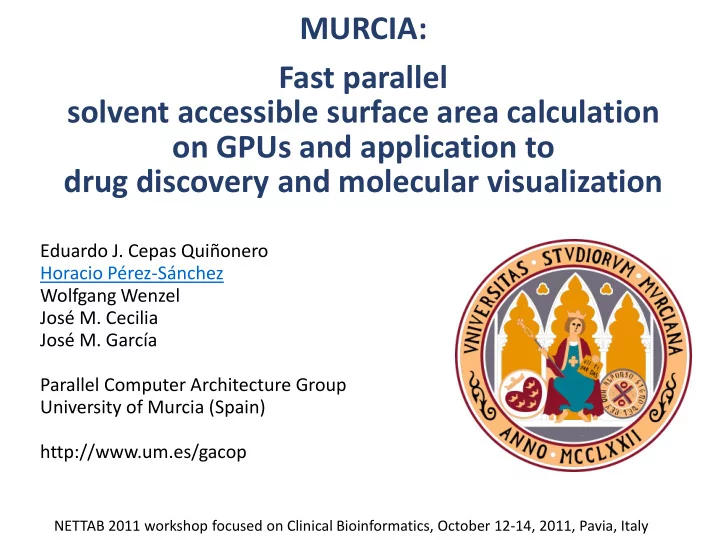

MURCIA: Fast parallel solvent accessible surface area calculation on GPUs and application to drug discovery and molecular visualization Eduardo J. Cepas Quiñonero Horacio Pérez-Sánchez Wolfgang Wenzel José M. Cecilia José M. García Parallel Computer Architecture Group University of Murcia (Spain) http://www.um.es/gacop NETTAB 2011 workshop focused on Clinical Bioinformatics, October 12-14, 2011, Pavia, Italy
INTRODUCTION METHODOLOGY RESULTS CONCLUSIONS AND OUTLOOK
Drug Discovery process
Methods for ligand and multiple target database screening: Screening in laboratory: • Automatized, • but expensive • and time-consuming Virtual Screening • Search for leads • As pre-stage for exp. tests
Methods for ligand and multiple target database screening: Definition of Virtual Screening Screening in laboratory: Use of high-performance computing to analyze large databases of chemical compounds ( tenths of millions or even more!!! ) in order to identify possible • Automatized, drug candidates. • but expensive • and time-consuming W.P. Walters, M.T. Stahl and M.A. Murcko , “Virtual Screening-An Overview ”, Drug Discovery Today , 3, 160-178 (1998)) Our proposal Use GPUs instead of Supercomputers to overcome computational bottlenecks from Virtual Screening calculations, ongoing trend in bioinformatics Horacio Pérez-Sánchez and Wolfgang Wenzel. “Optimization methods for virtual screening on novel computational architectures”. Current Computer-Aided Drug Design , 7(1):44 – 52, 2011. G.D. Guerrero, H. Pérez-Sánchez, J.M. Cecilia, J.M. García , (2011) “Parallelization of Virtual Screening in Drug Discovery on Massively Parallel Architectures” (submitted). H. Pérez-Sánchez, G. D. Guerrero, I. Sánchez-Linares, J. M. Cecilia, J. M. García, I. Martínez-Martínez, J. Navarro-Fernández, V. Vicente-García, J. Corral, I. Meliciani and W. Wenzel. “High Throughput Virtual Screening against flexible protein receptors; implementation on GPUs and application to the discovery of novel scaffolds for the modulation of antithrombin anticoagulant activity“, In: “XI Congreso de la Sociedad de Biofísica de España ”, Book of abstracts ISBN 978 -84-694-3422-2, pp 217 (2011).
” No hay problemas pequeños. Los problemas que parecen pequeños son grandes problemas que aun no se entienden. ” “ There are no small problems. Problems that appear small are large problems that are not yet understood .” Santiago Ramón y Cajal Spanish Physician 1906 Nobel Prize in Physiology “small problem” molecular surface calculation “large problem” accuracy and speed
INTRODUCTION METHODOLOGY RESULTS CONCLUSIONS AND OUTLOOK
Calculation of the list of neighbours Unburied surface of each atom depends only on overlapping with neighbours
Each atomic surface – > grid generation 590 points lebedev grid with matlab Lebedev, V. I, and Laikov, D.N. A quadrature formula for the sphere of the 131st algebraic order of accuracy. Doklady Mathematics 59, 477 – 481 (1999).
Individual atomic surface integration 1) Procedure is done for all grid points of atom i; we will have n non- buried grid points 2) Individual SASA for this atom will be calculated according to a (n/72) fraction of the sphere surface.
Molecular surface visualization • MURCIA has also the abilty to generate files with the information of grids coordinates in order to be used in molecular graphics programs like Pymol. • We can check the generated grid points and the calculed out points
Overlapping of atomic grids
Unburied grid
GPU Architecture overview NVIDIA Tesla C1060 GPU with 240 Streaming processors “Classical” CPU CUDA: NVIDIA. NVIDIA CUDA Programming Guide 4. (2011).
SASA on GPU: grid generation List of atoms Grid points Each thread computes a particular atomic grid point on a streaming processor (240)
SASA on GPU: neighbours List of atoms Neighbours Each thread computes a list of neighbours for each atom
SASA on GPU: Unburied points Atomic grids Unburied grids Each thread computes whether each grid point is buried or not, and stores its index
INTRODUCTION METHODOLOGY RESULTS CONCLUSIONS AND OUTLOOK
Accuracy Comparison with POWERSASA (analytical, Klenin 2011) and MURCIA • Figure shows an overall good concordance between both methods • POWERSASA uses a very accurate method for the calculation of SASA Klenin, K.V., Tristram, F., Strunk, T. and Wenzel, W. Derivatives of molecular surface area and volume: Simple and exact analytical formulas. J Comput Chem 32, 2647 – 2653 (2011).
Speed Comparison of timings for SASA calculation using MURCIA and POWERSASA • In terms of performance, in the interval of 10 to 17000 atoms, MURCIA runs faster than POWERSASA, achieving maximum speedups of 15X. • We have also checked that MURCIA runs around 30X times faster than MSMS (Sanner 1996). • Sanner, M.F., Olson, A.J. and Spehner, J.C. Reduced surface: an efficient way to compute molecular surfaces. Biopolymers 38, 305 – 320 (1996).
INTRODUCTION METHODOLOGY RESULTS CONCLUSIONS AND OUTLOOK
Conclusions and future work • We have developed a fast and efficient method on GPU hardware for: • SASA calculation, used in implicit solvation models • accelerated visualization of molecular surfaces (VMD, Chimera, Pymol) • The method is not yet optimal and there are several improvements we are working on: • Influence of different grids strategies on accuracy • better strategy for neighbour’s list: 100X faster • Implemented in the fast blind Virtual Screening program BINDSURF • Application to: • General Born electrostatics • Quantum Chemistry codes
Acknowledgments Funding Group members European Commission FEDER • Spanish Ministry of Science (Ministerio de • Educación y Ciencia, MEC) Irene Sánchez Linares • Fundación Séneca Región de Murcia • Ginés D. Guerrero • University of Murcia • Eduardo Cepas-Quiñonero • Horacio Pérez-Sánchez • José M. Cecilia • José M. García • Further questions, discussion, etc: Come by! horacio@ditec.um.es
Recommend
More recommend